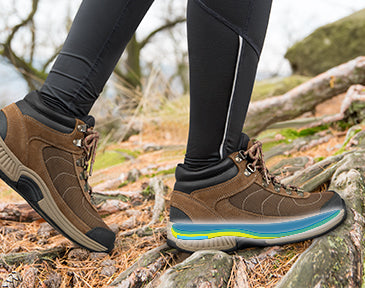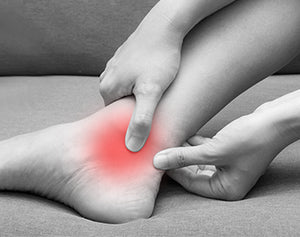The Orthofeet Blog
- All Posts
- All
- Arch Support
- Back Pain
- Bunions
- Diabetes
- Flat Feet
- Foot Pain
- Hammer Toes
- Heel Pain
- Heel Pain/ Heel Spurs
- Knee & Hip Pain
- Knee pain
- Morton Neuroma
- Orthopedic shoes
- Other
- Overpronation
- Plantar Fasciitis
- Swollen Feet
Plantar Fasciitis


Josh White DPM / August 12, 2021
Hiking with Plantar Fasciitis: What You Need to Know
Hiking with Plantar Fasciitis: What You Need to Know
Read Post-
Why Do My Feet Hurt Everyday? Understanding Daily Foot Pain
Medical information provided by Josh White DPM / November 01, 2024Discover why your feet hurt every day and learn about solutions to alleviate daily foot pain with Orthofeet's expert tips and recommended orthopedic products.Read More -
Pain on Outside of Foot: Orthopedic Shoes for Lateral Foot Pain
Medical information provided by Josh White DPM / November 01, 2024Explore the common causes and treatments for pain on the side of the foot. Learn how the right footwear can help manage and prevent outside foot pain.Read More -
How Your Feet Impact Knee and Hip Pain
Medical information provided by Steven Gershman DPM / May 16, 2017Your knees and hips are the largest joints in your body. They are responsible for supporting your weight as you stand and walk. If you are experiencing chronic pain in your hips, knees, or even in your lower back, shoulders and neck, there may be a connection between the pain and the way your feet function. Walking is good for you, right? Absolutely. But beware of poor walking habits that can cause or exacerbate knee and hip problems. On the positive side, however, a safe and smart walking regimen can help improve joint problems, not to mention how good it is for your overall health. Knee pain Watch your feet. If you are prone to foot problems, such as hypermobile feet (when the joints in and around the feet move more than they should) or fallen arches caused by over pronation, your gait may be compromised. And this change can cause unnecessary stress on the knees, resulting in painful injuries. Research how to prevent fallen arches and join paint. Joint pain caused by a foot problem or a runner's knee should be avoided by paying close attention to how your body moves. The knee is made to bend only in one direction—facing straight forward. When the foot over-pronates, the leg rotates inward toward the opposite leg. This causes the knee to flex and extend while pointing inward and not in the normal direction, which puts stress on the knee. People who suffer from osteoarthritis pain have worn cartilage on the inside (medial) area of their knee joint. Research is being done to determine how walking differently can help manage this pain. According to the Arthritis Foundation, studies are finding that pointing your toes slightly outwards (about 7°) when you walk will shift pressure to the outside (lateral) part of the knee, relieving the pain radiating from the inside of your knee joint. Ask your doctor if this change in the way you walk can help your situation. Runners knee (which is not exclusive to runners) is identified by a throbbing pain on your kneecap. The impact of your foot hit the ground causes your kneecap to rub against the femur bone. If you have a misaligned kneecap or previous injury, your knees are more vulnerable. Other causes are weak thigh muscles, soft knee cartilage, or flat feet. Consider investing in a knee brace to support the affected joint and reinforce the ligaments in your leg to prevent severe pain. Also, explore arch support inserts for men and women shoe inserts to further support your feet and ensure you get the right level of comfort and stability tailored to your needs. Hip pain Pain from bursitis is felt on the outside of your hip, whereas arthritis is felt on the inner hip near you groin. Relief from each requires different walking treatments. Repetitive stress (including excess walking or running) can cause the bursa that cushions your hip to become inflamed. Another cause of bursitis is exercising without proper warm-ups and cool downs, which are a vital part of any program. You need to follow a very slow walking regimen when recovering from a bout of bursitis. This involves gradually increasing the frequency and length of your walks. As with osteoarthritis in general, the cause of hip or knee arthritis can be genetic. It can be a hereditary or a congenital problem with an improperly formed hip joint. Hip arthritis can also develop from an injury or trauma to the hip area, or stress from excess weight or activity. Seek pain relief by contacting a physician who can provide you with information regarding physical therapy to treat any affected joint. The problems caused by flat feet overpronation, which were discussed for knee pain, are also true for the hip joint. When the foot pronates, the leg rotates inward and the hip can become unaligned. This condition puts stress on the hip and on the entire leg muscles. How to help your knees and hips Any problem with the foot or ankle resulting in a compromised posture or gait can lead to knee and hip pain. Examples of common foot problems that can lead to poor posture and irregular walking patterns include: Plantar fasciitis, which can lead to chronic heel pain and/or arch pain Nerve pain or numbness in the foot (such as tarsal tunnel syndrome) Research the best shoes for Morton’s neuromas to relieve your pain. Bunions and bunionettes (big-toe versus little-toe side, respectively) Explore the best shoes for bunionettes to suit your needs. Excessive foot pronation (rolling in) or supination (rolling out) Find the best podiatrist-recommended shoes for supination When you experience pain and you are diagnosed with a dysfunction in the foot or ankle, it may be possible to reduce the knee and hip pain by improving foot function, using proper footwear and orthotic insoles. A Harvard medical school health publication advises that exercise is an important treatment for arthritis. It improves the strength and function of the afflicted area(s). In many cases, a moderate walking plan is recommended to alleviate such pain. It is considered a low impact activity that strengthens the supporting muscles, relieving the pressure on the joint. Be sure to walk on a smooth, soft surface such as a track or treadmill. Your doctor or physical therapist can advise how much walking is best for you. An extra bonus is walking will help with weight loss, which takes some stress off your joints. When you compensate for pain by limping or walking with an abnormal gait, other joints can suffer wear and tear. Your rheumatologist, orthopedic doctor or physical therapist can help determine if changing your walking gait could help reduce pain. Many PTs will video patients as they walk on a treadmill and then review their walking habits to determine what pain reduction improvements can be made. You can make a conscience effort to minimize limping by holding your body straight without swaying and maintaining and even stride. The Right Shoe Regimen Healthy shoes play a significant role in knee and hip pain management. Here are a few tips on orthopedic shoes and why you should wear them. Never wear heels over two inches high. Heels increase the risk of knee joint degeneration. However, not all flat shoes are good for your feet. Flats that do not provide any arch support can lead to knee, hip, and back pain. Get the right fit. Tight shoes can cause limping from foot pain. Oversized shoes can also impair your gait. Either way, you’ll be putting unnecessary stress on your knees and hips. Orthopedic sneakers & tennis shoes provide cushioning and help control over pronation. They also relieve the ball of the foot, which helps arthritic pain in the hip, knee, foot or ankle. Check out the article overpronation vs underpronation to learn more about these conditions. Replace your shoes as needed. When the supporting cushioning becomes worn, it is no longer helpful. If knee or hip pain is due to your foot function, the proper footwear along with orthotic insoles can be a very effective way to relieve symptoms. Invest in quality shoes that are specifically made for your condition. OrthoFeet provides the ability to browse shoe selections that meet your needs. Explore our range of footwear designed to offer comfort and support. Whether you're looking for women's wide shoes, arch support shoes, men's walking shoes, shoes for flat feet, or plantar fasciitis shoes, each Orthofeet collection is tailored to meet specific needs, helping you find the right fit for your feet.Read More








